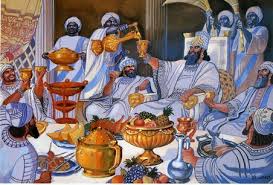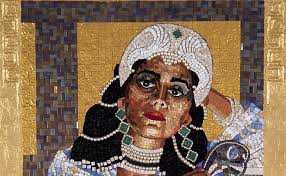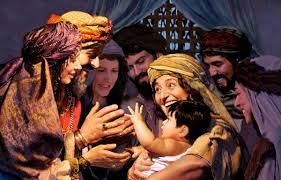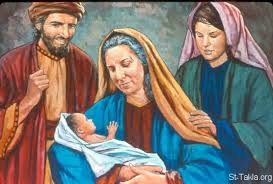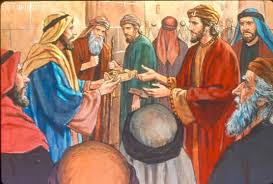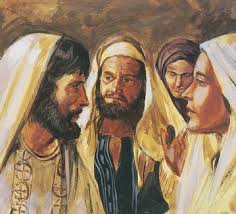Al – When Queen Vashti Refused to Come, The King Became Furious 1: 10-22
When Queen Vashti Refused to Come,
The King Became Furious and Burned with Anger
1: 10-22
When queen Vashti refused to come, the king became furious and burned with anger DIG: Why does king Ahasuerus send for her? When she refuses, how does he react? Who advises the king what to do and why? Who were the magi? What was their advice? Why did it backfire? What would cause the government to establish a law that could not be repealed? Why did God hide His face from His people within the text?
REFLECT: How different is to be the attitude of the godly man toward his wife compared to that of the Persian court (see my commentary on Genesis, to see link click Lv – I Do Not Permit a Woman to Teach or Have Authority Over a Man, She Must Be Silent). Has there been a time in your life when it felt like God had hidden His face from you because of your sin and disobedience, only to discover later that He was actually there all the time? What did you learn from that experience? How can you help others?
The author of the book of Esther knew when he began to write that he was telling a story about how, against all odds, the fate of God’s people was reversed and became the reason for the celebration called Purim. One seemingly insignificant event led to another, leading to the fulfillment of the Covenant between the LORD and His people. It is, therefore, worth noting what event started that chain reaction.
He did not begin with Mordecai or Esther. He did not repeat the history of the Jews. He begins with a Persian king named Ahasuerus, who did not know or worship ADONAI. But he decided to host a banquet, apparently for purely political need to solidify support for his impending military campaign against Greece. Therefore, a completely pagan king decides for purely worldly reasons to give a banquet designed for his own ego trip. On the last day of the banquet he decides to give the men of his empire a good look at his beautiful Queen Vashti. But she refused to come, and with that one decision she sets in motion a chain of events that leads to the deliverance of God’s people in Persia.14
On the seventh day, when King Ahasuerus was in high spirits from wine, he commanded the seven eunuchs who served him – Mehuman, Biztha, Harbona, Bigtha, Abagtha, Zethar and Charkas (1:10) – to bring before him Queen Vashti (1:10a). The eunuchs are listed here for a reason. Their names serve to verify the event, and because they were eunuchs, they could be trusted to go to the queen and bring her safely to the king. Seven seems to be the number needed to carry her seated in the royal litter. This would create a dramatic and majestic entrance for her before the men being asked to go to war for the empire. Perhaps the sight of the queen in her royal splendor was intended to inspire patriotism and loyalty, as public appearances of the British queen today.
Today, most of us think of excessive drinking as being totally unacceptable. But the Greek historian Herodotus informs us that the Persians drank as they deliberated important political decisions (3:15). As bizarre as it seems to us now, they believed that getting drunk put them in closer contact with the spiritual world. If Herodotus was right on this point, excessive drinking would have been an essential element of Ahasuerus’ war council.

To bring before him Queen Vashti, wearing her royal crown, in order to display her beauty to the people and nobles, for she was lovely to look at (1:10b-11). At the height of the bash, the king sent for Queen Vashti to come and display her beauty before the assembly of tipsy men. But when the attendants delivered the king’s command, Queen Vashti refused to come. Because Ahasuerus displayed his power and authority in order to solidify his nobles and military leaders behind his plan to conquer Greece, the refusal of his own queen to obey his command must have been extremely embarrassing. No wonder the king became furious and burned with anger (1:12). The king needed his men to obey his commands as they went off to war, but in his own palace he could not even get his own wife to obey (art by Sarah Beth Baca: see more information on Links and Resources)!
Note that this passage is the first of many in which the author doesn’t make any moral or ethical evaluation. He does not fault Ahasuerus for drinking, nor does he commend or condemn Vashti for refusing to appear at the king’s command. This is an important element in the story and is especially fitting to its meaning and application, for the providence of ADONAI works through human behavior, even if it doesn’t always come with the best intentions.
Dear Wise Heavenly Father, Praise your wisdom that knows all that will happen, and You turn the events to Your own honor and glory! I am so thankful that as my Father, You are always working things out to glorify Your holy name. It is so awesome to know that You guide events to the glorious praise of His grace (Ephesians 1:6a, 12c and 14c). Praise how You work out our salvation in a wise and loving way with hesed kindness and grace (Ephesians 2:8) that we might be for Your glorious grace. He keeps working out all things according to the purpose of His will – so that we, who were first to put our hope in Messiah, might be for His glorious praise. (Ephesians 1:11b-12).
You know the future, even before it happens (Daniel 2 and 9). You know what people will say, before they even say it. Even before a word is on my tongue, behold, ADONAI, You know all about it. (Psalms 139:4). It is such a comfort to know that You always watching over to protect Your child. No hurt can sneak up on me. Though hurts and trials do come, You are by my side to help, guide and to encourage. If God is for us, who can be against us? (Romans 8:31b). Life’s problems will soon be over. For I consider the sufferings of this present time not worthy to be compared with the coming glory to be revealed to us (Romans 8:18). A wonderful lifetime of peace and joy in heaven with You will go on for all eternity. I am so thankful that You my Daddy who knows and controls the future! I love you and delight in pleasing you! In Yeshua’s holy name and power of His resurrection. Amen
It is important to understand that this opening scene is not about drinking, sexism or husband-wife relationships. Instead, this conflict between Vashti and Ahasuerus provides a context in which later events of the story can be understood. The point of her fall from grace is that the Persian court was not a safe place because the king held such great power and wielded it so unpredictably. Actually, none of the principle characters are presented as ethical role models to imitate. Rather, the snapshot here provides a backdrop for the major conflict of the story when all the power of the Persian empire is turned against the Jews.15
Although he was powerful, it was customary for the king to consult experts in matters of law and justice, he spoke with the magi (see my commentary on The Life of Christ Av – The Visit of the Magi). They were a traditional institution, such consulted by Pharaoh (Genesis 41:8), and Dani’el was among their number at Babylon in the time of Nebuchadnezzar. They supposedly understood the times, which they believed to be strictly favorable occasions for action according to the stars. But here the expression seems to mean that they knew what to do (1:13).
And were closest to the king – Karshena, Shethar, Admatha, Tarshish, Meres, Marsena and lastly, Memukan, the seven nobles of Persia and Media who had special access to the king and were highest, or the best, in the kingdom. These names are Persian, but of course the rabbis attempted to give Hebrew meanings to them. “According to law, what must be done to Queen Vashti?” he asked. “She has not obeyed the command of King Ahasuerus that the eunuchs have taken to her” (1:14-15). These royal advisors were also experts in politics and Persian law. They saw the king’s face, meaning they talked to him face to face, a rare privilege. This counsel of seven is confirmed by Ezra 7:14, Herodotus and Josephus.
Then Memukan replied in the presence of the king and the nobles: Queen Vashti has done wrong, not only against the king but also against all the nobles and the peoples of all the provinces of King Ahasuerus (1:16). Apparently Memukan’s answer was meant to justify the king’s behavior and thereby maintain his favor. For the queen’s conduct will become known to all the women, and so they will despise their husbands and say: King Ahasuerus commanded Queen Vashti to be brought before him, but she would not come (1:17). Their reasoning will be, “The queen did not obey, therefore, we need not obey.”
This very day the Persian and Median women of the nobility who have heard about the queen’s conduct will respond to all the king’s nobles in the same way. There will be no end of disrespect and discord (1:18). The thought of female jokes and gossip was evidently enough motivation for a new royal decree, though how it would be enforced is not considered in the slightest. Were they really so pompous that they thought they could legislate respect and obedience from their wives? The whole notion was so absurd that it could only cost the king their respect.
Therefore, if it pleases the king, let him issue a royal decree and let it be written in the laws of Persia and Media, which cannot be repealed (1:19a). The irrevocability of the king’s decree is also mentioned in a similar situation in Dani’el 6:8, 12, 15. There, Darius, the father of Ahasuerus, is manipulated by his magi to issue an irrevocable decree forbidding prayer – a ploy intended to trap the godly Dani’el. There is no extra biblical evidence that Persian laws could not be repealed, so the statement here merely satirizes the way the authority of the Persian monarchy was perceived, not the way it actually operated.
So what began as an issue between two people suddenly took on a life of its own. The magi represented by Memukan were clever but hardly wise. By escalating the incident Memukan not only expressed his own anxiety and fears in terms of the good of the empire, but he also manipulated King Ahasuerus to his own advantage. Later, Haman would use the same ploy against the Jews in 3:8.16
Vashti was never again to enter the presence of King Ahasuerus. Memukan would have good cause to fear the vengeance of Vashti if she should regain the throne. We are not told what happened to Vashti. The rabbis teach that she was executed, and judging from the number of deposed queens in the East they are probably right. This is the first time in the book that Queen Vashti is referred to simply as Vashti. Also let the king give her royal position to someone else who is better than she (1:19b). Whenever a feast was held, there was a role reversal. The demise of Queen Vashti opened the door for the arrival of Queen Esther. Providence!
Then when the king’s edict is proclaimed throughout all his vast realm, all the women will respect their husbands, from the least to the greatest (1:20). The story of Esther takes place in Persia. Those Jews living there had chosen to be disobedient and not return to the Promised Land (Ezra 1:2). Many had been absorbed into the Persian culture, and to make their lives easier they began to worship other gods. But ironically, that’s why they were sent into exile in the first place (Ezeki’el 8). In doing so, ADONAI said that He would hide His face from them. God said to Moses: You are going to rest with your fathers, and these people will soon prostitute themselves to the foreign gods of the land they are entering. They will forsake Me and break My Covenant I made with them. On that day I will become angry with them and I will hide My face from them. Many disasters and difficulties will come upon them, and on that day they will ask, “Have not these disasters come upon us because our God is not with us?” And I will certainly hide My face on that day because of all their wickedness in turning to other gods (Deuteronomy 31:16-18).
Because Isra’el had been disciplined for chasing after other gods by first, being taken from the Land, and secondly, for not returning to it, God was hiding His face from them in the text (1:20; also see 5:4, 5:13 and 7:7). Within the phrase all the women will respect, is the name of YHWH (see my commentary on Exodus At – I Am Has Sent Me to You). It is formed by the initial letters of four consecutive Hebrew words when read backwards: Hy’ Wkl Hnsym Ytnw.17 He may have hidden His face from them, but He had not abandoned them. That’s the point of the book of Esther. Hiding His name in the text was like a code to the Jews. It was as if He was saying, “Don’t worry, I AM here, I have not abandoned you.” Later the writer to the Hebrews will remind them again: Never will I leave you; never will I forsake you (Hebrews 13:5b).
One rabbi taught that the reason God’s name could not be found plainly in the text was the author knew that the Persians would copy it and he did not want God’s name to be used for idolatrous purposes.
The king and his nobles were pleased with this advice, so the king did as Memukan proposed. He sent dispatches to all parts of the kingdom, to each province in its own script and to each people in their own language, proclaiming that every man should be ruler over his own household (1:22-22). The edict could hardly fail to strike the recipients as utterly ridiculous. Ironically, by accepting Memukan’s advice, the king ended up publicizing his embarrassment throughout the entire empire. His decree that every man should be ruler over his own household was something that he had just failed to do.
The episode in Esther 1:10-22 forms the background in which the threat of a Jewish holocaust at the hands of Persia can be grasped. The power of the most powerful nation in the world was conducted at the whim of the magi who manipulated the king with great skill. A society that was supposed to be based on law and justice, was, in reality, based on the egotistical needs of glory for the king and the insecurity of his advisors. Here, so-called Persian “law” was made up on the spot by drunken men. The king’s court was a dangerous place indeed. The Vashti story set the somber tone for her successor. Ahasuerus’ next queen would think twice before daring to go against the king.
When we think of the history of God’s people, we think of the great miracles that display the power of ADONAI. But these mighty acts of the LORD are linked together through long years of human history by a chain of seemingly insignificant, ordinary events. We are living in such a time. Like King Ahasuerus of long ago, modern kings, presidents and rulers make decisions for purely political reasons. And like Vashti, we make decisions that have long-reaching consequences without even knowing it, that are far beyond what we could predict. These decisions by those in authority over us may be completely secular with no thought of Christ whatsoever. But as believers we need to understand that through those secular decisions, God is moving human history forward to accomplish everything that must happen before the return of His Son, Yeshua Messiah, the true KING of kings.



